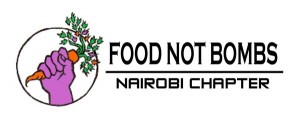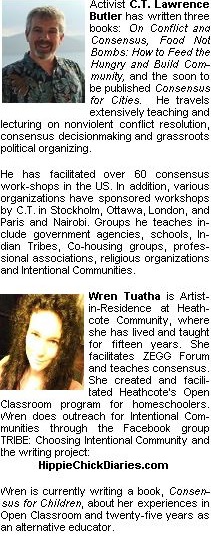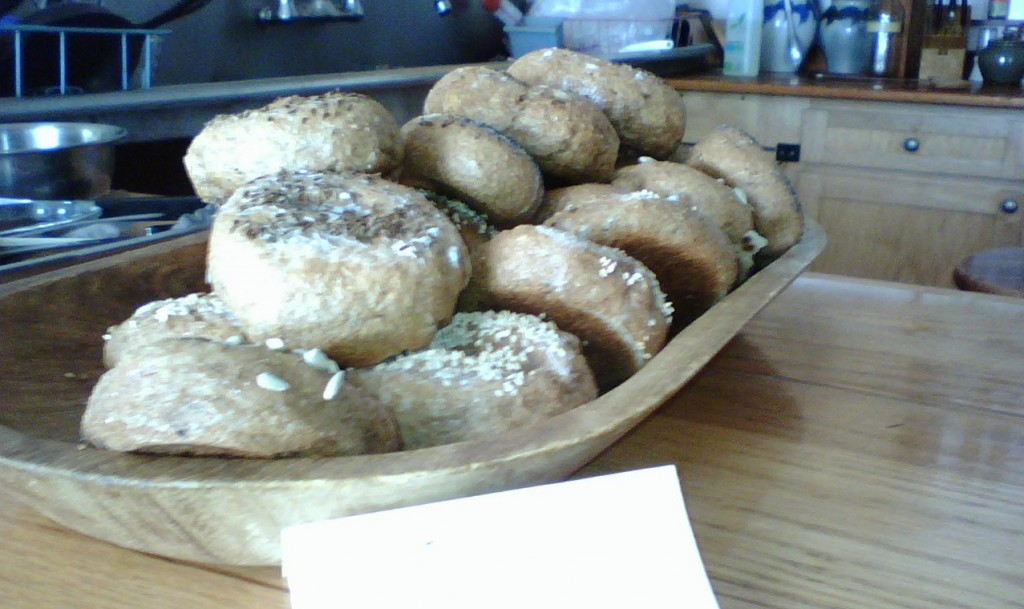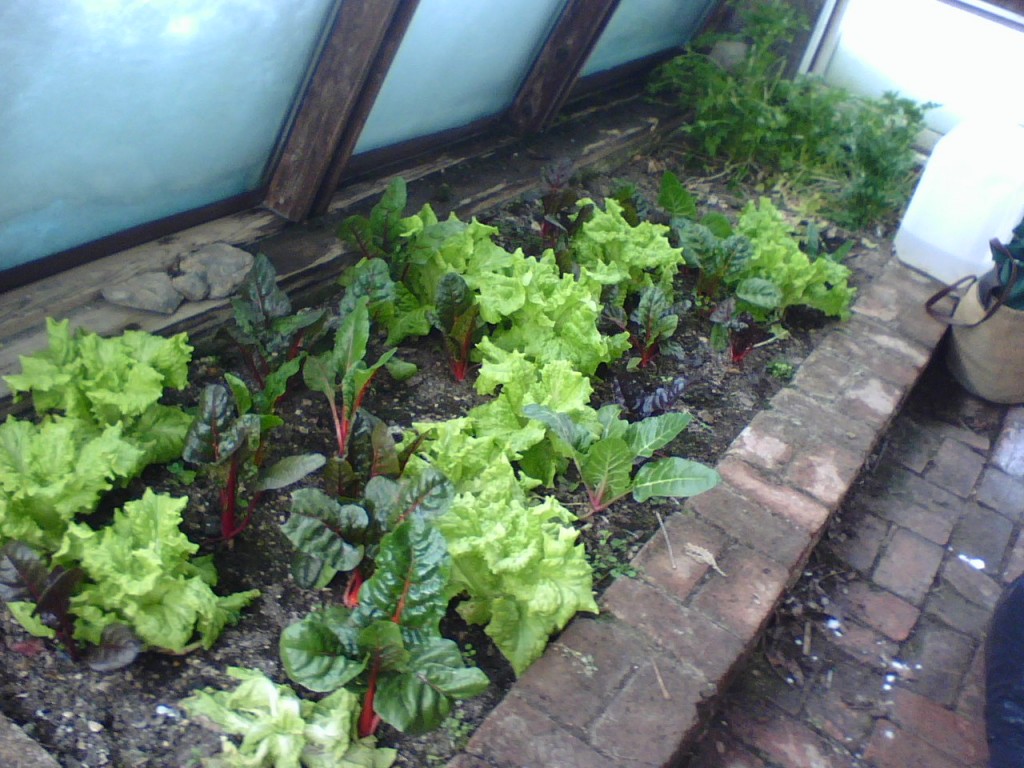National Poetry Month: Make Soup, You Said
Previously published in The Baltimore Review and the poetry anthology Blood and Tears. Upcoming in Avatar Review.
Make Soup, You Said
 I’m making a soup
I’m making a soup
to fill my bowl.
I’m after that carrot of consolation
you dangle.
I would remember
a recipe
uttered
in that season of my childhood
without language.
The three sisters–
corn, beans and squash…
When they hold hands
they can give weight
while they dance and stir,
balanced in a circle chain,
resolved, complete.
 If I know the right herbs,
If I know the right herbs,
if my flame is humble,
if I stir with the tide,
if I ladle with steadiness,
if I eat with grace,
if I digest with stillness,
I will understand
why you have gone.
I wrote you a letter.
I burnt it,
buried it,
scattered it,
sent it sailing,
nailed it to my bed.
Make soup, you said, nothing is simple.
–Wren Tuatha
Join our Hippie Chick Diaries fanpage on facebook!
About Make Soup, You Said: Some experiences just can’t be tied up with a bow. I wrote this poem in my process of trying to make sense of the death of my biological father. He had been gone since I was three. As an adult, I learned that he had died several years before after a life of homelessness. Realizing that I needed to nurture myself and that the situation had many ingredients, soup was the perfect metaphor. I intentionally avoided telling his or my story narratively. Instead I preferred to keep the poem general, like a love song on the radio, so the reader can apply it to their loss, their absent person. Nothing is simple. –WT
Editor’s Note: This post will be closed beginning in June, when Make Soup, You Said will appear in Avatar Review.
Subscribe to this blog's RSS feed
A Well-Fed Kenya: Food and Photojournalism
 Some stories enter my bones and don’t leave. The story of Nairobi Food Not Bombs is in my marrow and vibrating, refusing to be ignored.
Some stories enter my bones and don’t leave. The story of Nairobi Food Not Bombs is in my marrow and vibrating, refusing to be ignored.
As C.T.’s partner, I’m a witness to the daily news feed of Food Not Bombs arrests and court cases, mostly here in the U.S. In addition, he gets a steady stream of calls all day, mostly people asking advice on consensus and also starting a Food Not Bombs.
One such FNB startup was germinated from C.T.’s trip to Nairobi, Kenya, in 2007. He was there to teach consensus at the IndyMedia Convergence, in advance of the World Social Forum.
IndyMedia is an amazing case study in do-it-yourself journalism, personal and collective empowerment. IMC “converges” at the site of each World Social Forum, a week or so before the WSF begins, to teach grassroots journalism to non-corporate press from all over the world.
The convergences are temporary Intentional Communities that operate by consensus. Workshops teach would be journalists from Africa, South and Central America, Europe and the U.S. in street-level skills like building radios and transmitters out of materials available where they live.
At the Nairobi convergence, C.T. taught consensus and also pulled a hidden skill out of his hat—He taught IMC participants how to build a silkscreen press! This knowledge came from his early days of battling

C.T. teaches IMC journalists how to build and use a 3-color silkscreen press to generate fliers, books, posters, t-shirts, etc.
Seabrook Nuclear Power Plant, starting the first FNB collective, the start of ACTUP, etc.
The convergences are meetings of very different cultures. In Nairobi, C.T. was the “old guy.” While the Northerners (Europeans and Americans) gave him little rank and dismissed his efforts to teach, Africans sought him out and revered him as the elder in the group.
One such new friend erased C.T.’s name from a community chore chart and wrote his own in its place. “In my culture, elders do not do the dishes,” He said.
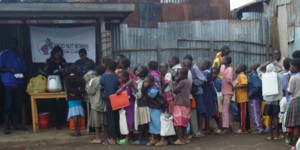 Douglas Rori, a convergence participant who was local to Nairobi, was so taken by C.T.’s stories of Food Not Bombs that he started a Nairobi chapter.
Douglas Rori, a convergence participant who was local to Nairobi, was so taken by C.T.’s stories of Food Not Bombs that he started a Nairobi chapter.
A Totally Different Ballgame
But unlike the twentysomethings who start chapters in their Midwestern college towns or face up against the police in Tampa, Florida, Doug and his Nairobi compatriots couldn’t just show up in the town square or public park with a table and pots of yummy vegan soup.
That’s a recipe for a food riot.
The hunger issue is not a minority issue there. Public feedings such as FNB is famous for the world over would put Doug and other volunteers at physical risk. Plus, with their food stolen, they would not complete their goal of serving the large population of street kids, mostly orphaned in the AIDS epidemic.
Sewing in the IndyMedia Thread
This is where the story gets dramatic in order to prevent drama.
Doug and other young Kenyan activists had the direct experience of how empowering it is to learn tools for telling personal and local stories; to be an alternative to the corporate press party line.
And they had learned filmmaking, photography and journalism in that way. Doug decided to disguise their feedings by offering journalism workshops to the homeless kids.
They chose enclosed courtyards and indoor spaces and spread the word about their workshops. As you can see by the photos, people of all ages came to learn.
And meals were included!
To keep this innovative project going, Doug has formed an NGO, A Well-Fed Kenya, in partnership with A Well-Fed World. This status enables him to operate and seeking funding on an ongoing basis.
Even with NGO status, life is still touch and go for Doug. An IndyMedia colleague was gunned down a few months ago in one of the ghettos, probably an assassination. Doug himself struggles to keep a roof over his own head as he does this important work.
To fund his project and stability for the coming months, we have collaborated with him on an Indiegogo campaign. Please
CLICK HERE TO VISIT OUR CAMPAIGN PAGE,
make whatever contribution you can, and tell your friends Doug’s amazing story! Let’s pull together to keep this project going in the ghettos of Nairobi!
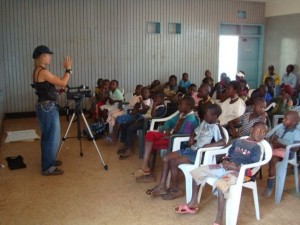 We are starting out with some popular perks from our previous Indiegogo campaign, Food Not Bombs t-shirts and copies of C.T.’s books, On Conflict and Consensus and Consensus for Cities.
We are starting out with some popular perks from our previous Indiegogo campaign, Food Not Bombs t-shirts and copies of C.T.’s books, On Conflict and Consensus and Consensus for Cities.
Doug is also making contact with some fair trade crafts cooperatives and exporters in Nairobi who may be willing to donate some of their jewelry and other crafts as perks for the campaign. So watch for additional perks!!!
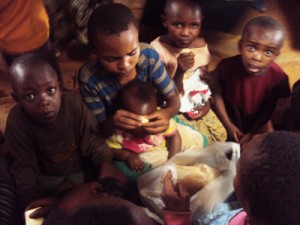 How can you get involved? Certainly, donating whatever you can is a huge start. Are you willing to join our campaign team and use Indiegogo share tools and social media to spread the word? Reaching out to people who don’t already know me, C.T. or Doug Rori is a great help.
How can you get involved? Certainly, donating whatever you can is a huge start. Are you willing to join our campaign team and use Indiegogo share tools and social media to spread the word? Reaching out to people who don’t already know me, C.T. or Doug Rori is a great help.
What ideas do you have for getting the word out about this impactful project?
If you’re in the D.C. region, C.T. and I can schedule a House Party with you. We can supply a slide show, talk about the project with friends you invite, and seek donations. Contact us at fiopa@consensus.net today to make arrangements!
Our main goals for now are to share this amazing story of risk, caring and daring and to get folks to visit our campaign page and donate. We must keep this work going!
When visiting the campaign site, do take the time to go through the photo gallery picture by picture. The interest of the kids in learning from Doug and his friends is amazing. You will understand from the numbers of people who attend that his offering is relevant and is making a difference.
What can you give today?
Social Technology Toolbox Summer Camp July 15-24, 2011
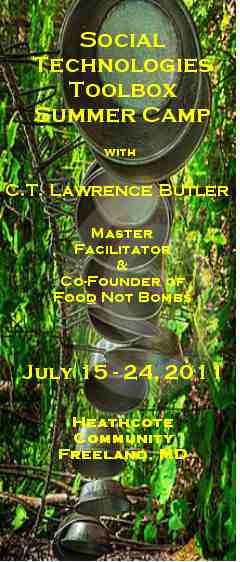
 How did we come up with the idea for a toolbox summer camp? C.T. Butler and I have been exploring how Intentional Communities and other groups succeed and how they understand (or often misunderstand) consensus. The idea of a “toolbox,” which members regularly update and use to build new culture, solve conflicts and grow as people, isn’t a new idea. What goes in it varies but adding to it seems key.
How did we come up with the idea for a toolbox summer camp? C.T. Butler and I have been exploring how Intentional Communities and other groups succeed and how they understand (or often misunderstand) consensus. The idea of a “toolbox,” which members regularly update and use to build new culture, solve conflicts and grow as people, isn’t a new idea. What goes in it varies but adding to it seems key.
More than just a technique like Non-Violent Communication, “consensus is a cultural paradigm…a way of being in the world,” writes trainer Maikwe Schaub Ludwig. Yet few people get much more than a day or two of training in this “way of being.” Many more find themselves practicing it with no training!
A space happened to open up in Heathcote Community’s education calendar. And when C.T. and I considered it for a weekend slot, we realized we had the chance to really help people go deep and get it!
We sprang into action and put together many of the ideas we’d been collecting. Ta dah! Toolbox Camp!
Below is the text of our brochure:
Are you currently part of an organization, activist group, non-profit, Cohousing or Intentional Community that’s having trouble with governance, decisionmaking or communication?
• Does your group feel a time pressure when making decisions?
• In discussions, does everyone speak?
• Does your group accomplish its goals?
• Do some people dominate? Is there burnout?
• Is the workload uneven? Organizational structure vague?
• Does it seem members just don’t hear each other?
C.T. Butler and Wren Tuatha been going deeper into the nature of consensus, how to teach it and how to help groups succeed. We’ve gotten clear that consensus is amazing and transformative, but that it’s a major paradigm shift for most groups. It’s more than just exchanging Robert’s Rules for Butler’s. C.T. isn’t just offering new software, so to speak, but a whole new operating system.
We are offering these skill building experiences designed to help Communities, activist groups, non-profits, spiritual groups, families, etc., succeed in their goals through awareness of the structures of group dynamics—decisionmaking, conflict resolution, mediation, listening, and communication that integrates head, heart and gut.
SOCIAL TECHNOLOGY TOOLBOX SUMMER CAMP
July 15-24, 2011
A 10 day immersion, starting with a weekend workshop called Consensus, Body and Soul. Then, together, we’ll create temporary consensus-based community. The mornings will be devoted to ZEGG Forum and deeper consensus workshops. Each 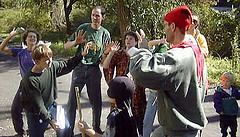 afternoon, we will add techniques and perspectives like Enneagrams, JoHari Window, Spiral Dynamics, Heart of Now, etc. The group will make decisions together at plenaries and participants can offerπ content of their own each evening through Open Space Technology.
afternoon, we will add techniques and perspectives like Enneagrams, JoHari Window, Spiral Dynamics, Heart of Now, etc. The group will make decisions together at plenaries and participants can offerπ content of their own each evening through Open Space Technology.
Simply, we’re all about finding the voice of the group. After thirty years in the field of consensus, C.T. presents a clear vision of egalitarian freedom through use of structure that brings the common values to life within the group.
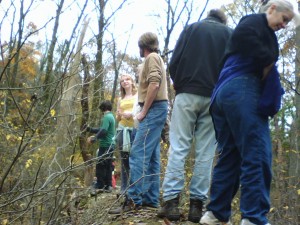 Some lessons are collected from other wise travelers, others are plucked from our own experiences in groups. Even as we make our offerings, the paradigm is leaderless and participant generated. We are curious about you. What do you bring?
Some lessons are collected from other wise travelers, others are plucked from our own experiences in groups. Even as we make our offerings, the paradigm is leaderless and participant generated. We are curious about you. What do you bring?
LOGISTICS
Request a brochure with the application form at curiocoast@comcast.net. Costs include fixed fees for materials, food and lodging, and a sliding scale for tuition.
Structured programming begins Friday evening, July 15. and ends at noon on Sunday, July 24. Lodging options are camping and the Heathcote Mill bunkroom. 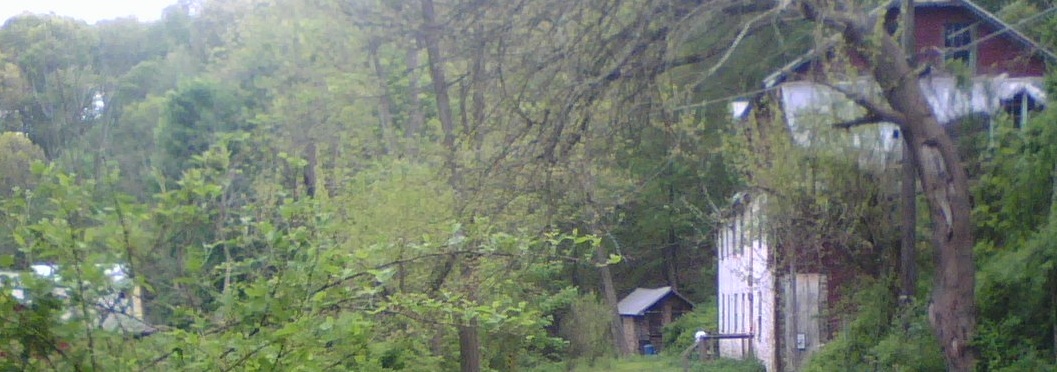 Accommodations are rustic and, like most forests, the land does have poison ivy/oak and ticks that carry lyme disease. Heathcote is a vegetarian facility, and drug and alcohol free. Carpooling is encouraged. You will receive a packet with directions, a Heathcote orientation, packing lists, schedules and other logistics upon registration. The packet will include requests for food allergy and other special needs information.
Accommodations are rustic and, like most forests, the land does have poison ivy/oak and ticks that carry lyme disease. Heathcote is a vegetarian facility, and drug and alcohol free. Carpooling is encouraged. You will receive a packet with directions, a Heathcote orientation, packing lists, schedules and other logistics upon registration. The packet will include requests for food allergy and other special needs information.
Please join our Hippie Chick Diaries fan page on Facebook!
Graffiti: The Subversive’s Hymnal in the Age of Earth, Inc.
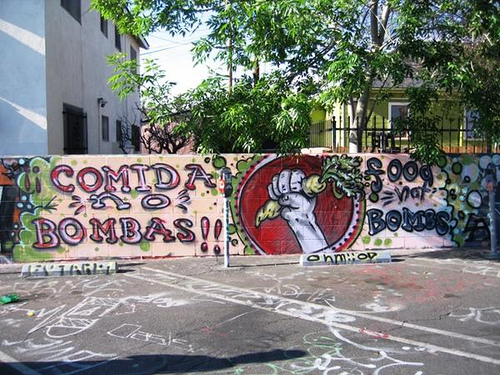 Although many of us in the Intentional Communities movement know C.T. Butler as a consensus trainer/ facilitator/mediator and the author of On Conflict and Consensus and Consensus for Cities, he is also the fountainhead and co-founder of the original Food Not Bombs collective. He’s co-author of Food Not Bombs: How to Feed the Hungry and Build Community, with FNB co-founder Keith McHenry.
Although many of us in the Intentional Communities movement know C.T. Butler as a consensus trainer/ facilitator/mediator and the author of On Conflict and Consensus and Consensus for Cities, he is also the fountainhead and co-founder of the original Food Not Bombs collective. He’s co-author of Food Not Bombs: How to Feed the Hungry and Build Community, with FNB co-founder Keith McHenry.
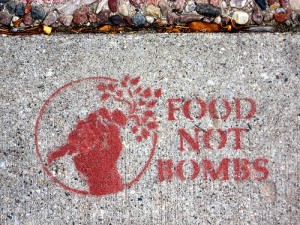 In his role as consensus trainer, he met Douglas Rori in Nairobi, Kenya. Both were attending the IndyMedia Convergence leading up to the World Social Forum there four years ago. They’ve stayed in touch and C.T. has closely supported Doug’s work in establishing a FNB chapter in Kenya. So when Doug posted his new film on facebook recently, I was electrified by the parallels of the use of graffiti in Africa with the stories C.T. has told me about graffiti as a central artistic tool in FNB and his other activism in the 1980’s. Of course, the artistic bar has been shot into the stratosphere, as depicted in the thought provoking documentary Exit Through the Gift Shop. And the art in Doug’s film is of that caliber.
In his role as consensus trainer, he met Douglas Rori in Nairobi, Kenya. Both were attending the IndyMedia Convergence leading up to the World Social Forum there four years ago. They’ve stayed in touch and C.T. has closely supported Doug’s work in establishing a FNB chapter in Kenya. So when Doug posted his new film on facebook recently, I was electrified by the parallels of the use of graffiti in Africa with the stories C.T. has told me about graffiti as a central artistic tool in FNB and his other activism in the 1980’s. Of course, the artistic bar has been shot into the stratosphere, as depicted in the thought provoking documentary Exit Through the Gift Shop. And the art in Doug’s film is of that caliber.
I want to share Doug’s link because, wherever activists are working, I love the power of delivering our messages on our own terms. This seems more and more important as we find ourselves living on Earth, Inc.
http://vimeo.com/20684850
Please join our Hippie Chick Diaries fan page on Facebook!
Bambi of Skyline Drive
C.T. Butler: Incredible Life; Indelible Stories
 C.T. Butler makes me look good. It’s my turn to cook the Heathcote Community dinner again and the consensus trainer/vegetarian chef and co-founder of Food Not Bombs is my guest and helper! Or more accurately on this day, I’m his helper.
C.T. Butler makes me look good. It’s my turn to cook the Heathcote Community dinner again and the consensus trainer/vegetarian chef and co-founder of Food Not Bombs is my guest and helper! Or more accurately on this day, I’m his helper.
Nearly all of the adult members of Heathcote take turns cooking dinners, which we share six nights a week. It comes out to cooking about twice a month. The rest of the nights, we just show up and get fed. Since we rotate, folks tend to make their specialties. So not only does someone else cook my dinner, but I get their best.
I don’t profess to have a best.
I observe with bewilderment people who savor cooking as a hobby, a joy, a vocation or avocation. I didn’t get that gene or whatever. Me, I like to eat well so I cook. I get no special creative satisfaction out of the process. Even so, since I like to eat well, I do know how to get a sparkle from my spicings.
 Cooking with C.T. is like taking a car ride with a war correspondent. We have consensed upon his traditional refried beans, a recipe that originated in El Salvador & Nicaragua. As he casually chops onions and garlic, he tries to remember the recipe from his days of feeding homeless people and protesters with Food Not Bombs. As he slices proportions down to feed the twenty or so we’re expecting, he’s reminded of arrests and police beatings and stories start to flow.
Cooking with C.T. is like taking a car ride with a war correspondent. We have consensed upon his traditional refried beans, a recipe that originated in El Salvador & Nicaragua. As he casually chops onions and garlic, he tries to remember the recipe from his days of feeding homeless people and protesters with Food Not Bombs. As he slices proportions down to feed the twenty or so we’re expecting, he’s reminded of arrests and police beatings and stories start to flow.
 Food Not Bombs just observed the thirtieth anniversary of the occupation of Seabrook Nuclear Power Plant (May 24, 1980). The six activists who would eventually rent a house together and establish the first Food Not Bombs collective, were all protesters at that event. When one of them, Brian Feigenbaum, was arrested, the others literally started holding bake sales for his defense! I’m reminded of the t-shirt/bumper sticker slogan, It will be a great day when the schools have all the money they need and the Air Force has to have a bake sale to buy a bomber.
Food Not Bombs just observed the thirtieth anniversary of the occupation of Seabrook Nuclear Power Plant (May 24, 1980). The six activists who would eventually rent a house together and establish the first Food Not Bombs collective, were all protesters at that event. When one of them, Brian Feigenbaum, was arrested, the others literally started holding bake sales for his defense! I’m reminded of the t-shirt/bumper sticker slogan, It will be a great day when the schools have all the money they need and the Air Force has to have a bake sale to buy a bomber.
Thus started a food/activism connection for the collective. “Most of us worked in restaurants at the time, cooks, waiters, etc., and we knew first hand the mountains of food that’s wasted,” C.T. explains. At first, the group collected the restaurant and grocery store leftovers hoping to feed themselves for free, liberating time and resources for their activism. But immediately they could see that they had discovered a resource far beyond their own needs. “Of course, we were activists, so our values were to see the food get used where it was needed,”
This took several forms. The collective gave food away in Harvard Square, which established the non-violent direct action template that eventually prompted clashes with police in cities around the world and arrests for serving food without a permit (although their home town of Cambridge, Massachusetts was supportive, negotiating with FNB and eventually naming C.T. Peace Commissioner). Food Not Bombs also catered demonstrations and direct actions, feeding participants so they could stay on site long hours, keeping the protests going.
Thirty years later, C.T. stands in the Heathcote Mill kitchen, mashing the pinto and black turtle beans in small batches, because we couldn’t find a masher with a long enough handle to reach the bottom of the pressure cooker. “I always say I’m mashing in the love, it looks violent but it’s made with love,” he smiles without stopping.
So many times, that sentiment has been spoken in this kitchen. I’ve heard many Heathcote members describe the act of feeding their community as one of nurturing and love. How broken and sad it seems to me that the FBI would eventually target Food Not Bombs as a “terrorist” organization. And that feeding the hungry would be viewed as a crime in dozens of cities over the globe, resulting in thousands of arrests of Food Not Bombs chapter volunteers the world over.
But right now, C.T. is feeding me and mine. As from that first Food Not Bombs collective house in Cambridge, Massachusetts, autonomous chapters operate by consensus. C.T. has written two books on consensus decision-making. And he’s had a long friendship with Heathcote through his consensus workshops. This community’s consensus on this meal is: forty thumbs up!
Repost: I Can Feel Them Slithering this Way…
 My nemesis/totem, the black rat snake, has arrived back at Heathcote on schedule this spring. This has me tenting again this year, since our project of jacking up my house created some gaps where snakes might again access my living space. Time to recall the famous story, reposted below. Click on photos for details. —WT
My nemesis/totem, the black rat snake, has arrived back at Heathcote on schedule this spring. This has me tenting again this year, since our project of jacking up my house created some gaps where snakes might again access my living space. Time to recall the famous story, reposted below. Click on photos for details. —WT
Sometimes the bogeyman is a flashback of some rapist or the echo of that ever negative parent. It could be that childhood biting dog or one’s inner voice. Or it could be a succession of 5-foot black rat snakes coming in through windows and walls. Okay, on a day in early May of last year, it was black rat snakes.
My dogs were already barking. This was an experience they’d clearly had before. A huge snake was outside on the window ledge, tracing a familiar path to a missing window pane covered loosely by plastic. The plastic was stapled in a couple of places, there to keep the rain out.
This would be a good time to mention that I have an understandable, justifiable childhood trauma around snakes. Okay, they’re sacred and symbolize earthiness and fertility and feminine power because we’re all past that myth in Genesis. But this means nothing to the six-year-old me that went crawdad huntin’ in Jack’s Creek on our farm in Kentucky.
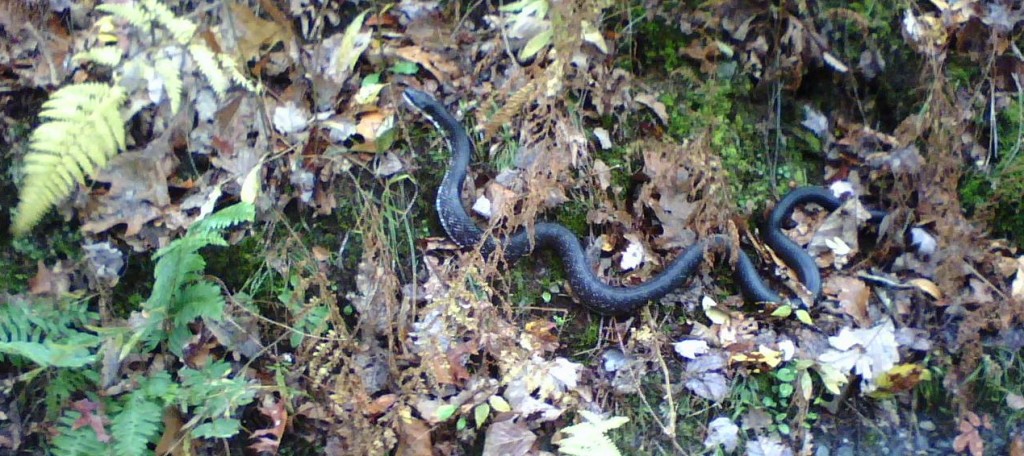 You may be thinking I mean crayfish hunting, but since I’ll have no dignity by the end of this story, I might as well confess now that my sister and I were crawdad huntin’.
You may be thinking I mean crayfish hunting, but since I’ll have no dignity by the end of this story, I might as well confess now that my sister and I were crawdad huntin’.
 Granny had driven us in her Olds 98 and outfitted us with her brand new kitchen bucket. Beth and I walked the creek, turning over rocks, jumping back when the bigger crawdads would torpedo out. We rounded a couple of bends, well out of sight of Granny, engrossed.
Granny had driven us in her Olds 98 and outfitted us with her brand new kitchen bucket. Beth and I walked the creek, turning over rocks, jumping back when the bigger crawdads would torpedo out. We rounded a couple of bends, well out of sight of Granny, engrossed.
This would be a good time to mention the Paul Bunyanesque stories my grandfather would tell about cottonmouth water moccasins. Pap claimed that they ate his dairy cows. And with each telling of how he’d gone out into the field and ended the behemoth with a shotgun, the snake got bigger and bigger. On our farm, snake stories were as fishing stories in this fashion.
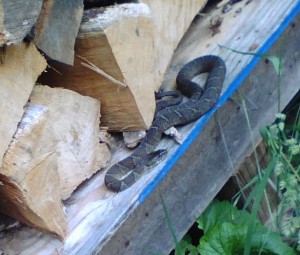 So when the cartoonlike meeting of engrossed girls and startled cottonmouth took place, there was only one way it could play out–epically. The snake reared up and met us face to face to face. It opened to showcase the cottony room of its mouth. We screamed in chorus with its scream and waved our hands in the air, sending the new kitchen bucket flying. We ran atop the surface of the water all the way back to Granny and the Olds 98, so as not to leave any footprints in the muddy creekbed for the snake to follow.
So when the cartoonlike meeting of engrossed girls and startled cottonmouth took place, there was only one way it could play out–epically. The snake reared up and met us face to face to face. It opened to showcase the cottony room of its mouth. We screamed in chorus with its scream and waved our hands in the air, sending the new kitchen bucket flying. We ran atop the surface of the water all the way back to Granny and the Olds 98, so as not to leave any footprints in the muddy creekbed for the snake to follow.
We told Granny about the snake and the face to face to face and the cottony room from the safety of the car. Now I loved my grandmother and she told me on many occasions that she loved me, too. But this was not her shining moment. I swear to you that her only response was, “You girls go back and get my bucket!!!”
I note for the record that she herself did not retrieve it, either.
So as the black rat snake poked at the plastic, I was amused to find myself considering covering the pane with my own kitchen bucket. Instead I grabbed the staple gun and began stitching a solid seem all the way around, just barely ahead of the snake’s nose. I won that race and darted outside only to watch the snake retreat into an opening under my house where my tub’s drainpipe protrudes. The snake got in anyway.
 I had lived in Hina Hanta, left, the Heathcote shack formerly known as the Hillhouse, for four years. And about two or three times a year I would come upon a small black snake inside. Now, I hate snakes for
I had lived in Hina Hanta, left, the Heathcote shack formerly known as the Hillhouse, for four years. And about two or three times a year I would come upon a small black snake inside. Now, I hate snakes for
understandable, justifiable reasons and I would evacuate with the dogs, wait a few hours and return with another Heathcoter to conduct an “all
clear.” This worked for me, barely, because I knew the snakes were catching mice and their bigger cousins. And for that reason I was glad of each one I encountered outdoors. But the snake in my window had no fear. This was new and unsettling.
 I was unnerved enough to leave the light on when I went to bed. I don’t know why I thought that would make a difference but I found it a comfort. One of my phobias around snakes and my life deep in the woods is that they’ll end up in bed with me. Fertility be damned, I ain’t having that!
I was unnerved enough to leave the light on when I went to bed. I don’t know why I thought that would make a difference but I found it a comfort. One of my phobias around snakes and my life deep in the woods is that they’ll end up in bed with me. Fertility be damned, I ain’t having that!
But two nights later the choice was not mine. I jolted up to the crazed barks of Echo, my brave protector of the two shelties. She was ranting and racing from the bed to the stairway of my loft room. The sight was simply a shocker: undulating across my floor, blocking my exit, were two five-foot long black snakes, mating, and I mean passionately. They showed no signs of being phased by our waking.
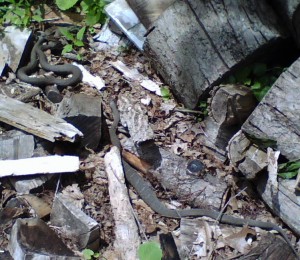 Evacuation being my policy I stood on my bed, holding both shelties by the collar with one hand and pulling clothes off a chair and onto myself with the other, all the while watching the snakes go on and on and on. I would have been struck awed and mystified by the beauty of their fluid movements if I were another person, without my understandable, justifiable fear of snakes. Instead I was all about escape.
Evacuation being my policy I stood on my bed, holding both shelties by the collar with one hand and pulling clothes off a chair and onto myself with the other, all the while watching the snakes go on and on and on. I would have been struck awed and mystified by the beauty of their fluid movements if I were another person, without my understandable, justifiable fear of snakes. Instead I was all about escape.
But when they finally untied themselves, the snakes were still flush with whatever hormones were giving them boldness and drive. One started to the right, finding the wall and turning toward my dresser, my bed and me. The other went left to the wall and started in my direction, using the dogs’ indoor agility tunnel to make its way toward the bed. I yanked the tunnel away and that snake was discouraged enough to retreat to the stairs where it disappeared into a hole in the wall. When I looked for the right hand snake, it had lifted its head to the top of the dresser. We split. We booked. We ran on the top of the water so as not to leave any footprints in the muddy creekbed for the snakes to follow.
 The next day, I brought Bob, a Heathcoter, up to the house, not for an all-clear, but to consult on plugging my many holes. As he stood in my bedroom hearing the story a black snake emerged from a seam where wall meets floor. It sat coiled, as if it were part of our discussion. These snakes without fear, this was so strange and new.
The next day, I brought Bob, a Heathcoter, up to the house, not for an all-clear, but to consult on plugging my many holes. As he stood in my bedroom hearing the story a black snake emerged from a seam where wall meets floor. It sat coiled, as if it were part of our discussion. These snakes without fear, this was so strange and new.
Bob became my champion at community meetings–”Wren shouldn’t have to live like this. She’s got snakes having sex on her floor!!! We’ve got to do something!!!” That was all well and good, but now huge snakes were slinking about at every turn I made. Kitchen, bathroom, upstairs and down, I came to estimate that I had between 8 and 10 five-foot long black rat snakes in my home and I was not in charge.
 My friend Charles is fond of saying that the wheels of community grind slowly. The Heathcoters were not going to disappear this infestation in a day or even a week. In the meantime I needed a place to sleep, alone with my dogs, alone, without snakes, alone.
My friend Charles is fond of saying that the wheels of community grind slowly. The Heathcoters were not going to disappear this infestation in a day or even a week. In the meantime I needed a place to sleep, alone with my dogs, alone, without snakes, alone.
Now, I had observed that black snakes don’t tend to chew holes or dig them. They avail themselves of ones created by the critters they’re hunting. This logic is what inspired me to set up my seven by seven Coleman tent in place of my bed. I believed that if I kept crumbs and such out that mice and their larger cousins would leave the fabric intact, thus creating all the barrier I needed to get a good night’s sleep. For the record, this is not a belief I need clarified in any way. it works for me. If you are of the impression or experience that a black rat snake might in fact chew through tent fabric, there is nothing to be gained by sharing. Do not email me.
The tent became my bedroom within a bedroom. I set up a power strip inside and plugged in my alarm clock and lamp. I inflated my aero bed and each night I called the dogs inside and zipped us within our hiding place.
Enter Mr. Hacker, the snake wrangler.
Although I admit to hating snakes as bogeymen I am an animal rights activist. In lucid moments I know that they’re just returning to their hatching site to breed, being good snake citizens. Even so, I can confess to having a few fantasies involving Pap’s shotgun because I know that I ultimately stuck to my beliefs, even when they were inconvenient. Mr. Hacker of White Hall was probably the tenth humane pest control person I called. The others had said that snakes couldn’t be trapped and that repellents didn’t work. Mr. Hacker had invented a successful trap from pvc pipe and a used eel trap. Bring it on.
 He installed the trap and decided to wait a while since I was so dripping with the things. For over and hour I listened to Mr. Hacker tell me stories of catching snakes. He would take the captured ones many miles away. “Sometimes I just slow down and pour ‘em out the window…” I didn’t need such details. He rambled on about family, the cousin who actually hacked up his wife’s lover in some bar, and wasn’t the family name ironic, I really didn’t need such details. Eventually a snake appeared on my stairs and he picked it up with his hands. “Wow, that’s a big one!” That’ll be thirty dollars. Here was hoping he slowed down enough for that one.
He installed the trap and decided to wait a while since I was so dripping with the things. For over and hour I listened to Mr. Hacker tell me stories of catching snakes. He would take the captured ones many miles away. “Sometimes I just slow down and pour ‘em out the window…” I didn’t need such details. He rambled on about family, the cousin who actually hacked up his wife’s lover in some bar, and wasn’t the family name ironic, I really didn’t need such details. Eventually a snake appeared on my stairs and he picked it up with his hands. “Wow, that’s a big one!” That’ll be thirty dollars. Here was hoping he slowed down enough for that one.
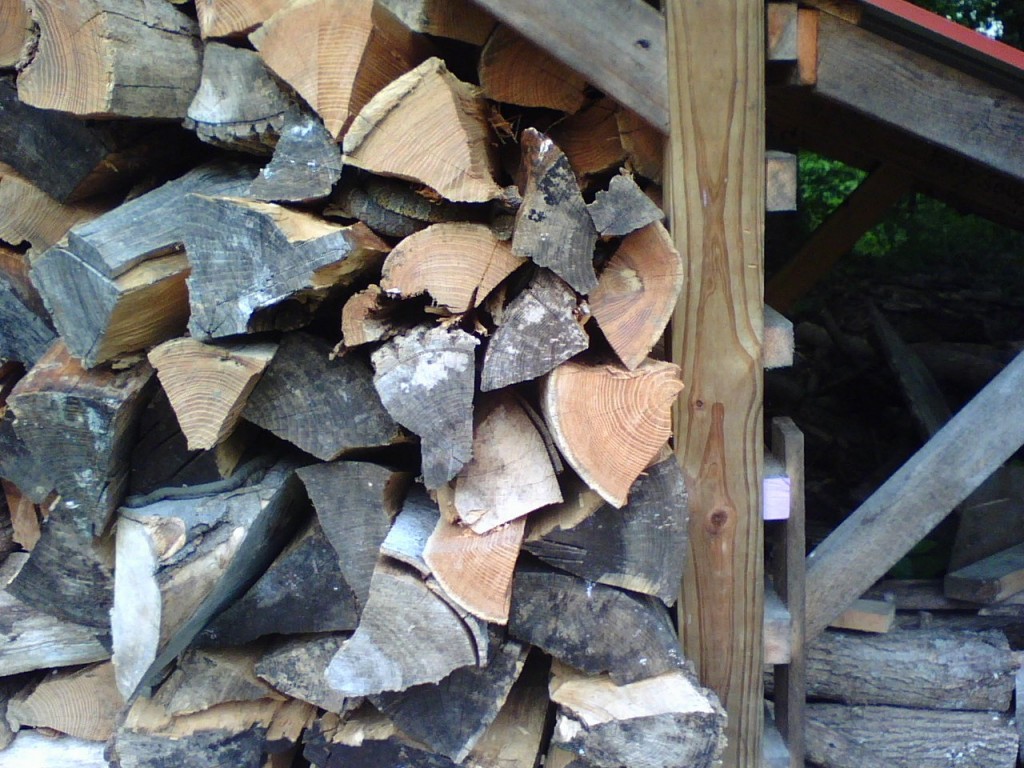 As Hacker’s trap caught one after another and sometimes two at a time, I got busy trimming every room and covering every possible entry, on the shack’s interior and exterior and winning my own eel traps on eBay. After a time the snakes stuck to the outdoors and the porch and became shy again.
As Hacker’s trap caught one after another and sometimes two at a time, I got busy trimming every room and covering every possible entry, on the shack’s interior and exterior and winning my own eel traps on eBay. After a time the snakes stuck to the outdoors and the porch and became shy again.
Homeschooling students attending the World Religions class on my porch helped me name the snakes and when we were not evacuating we were amused and amazed. And my students found my unusual bed amusing as well.
 It is winter now. Whether in my walls, some woodpile or rocky outcropping, I know the snakes are asleep. I know my holes are plugged. These nights I just climb in, I don’t zip the door closed. But life is a spiral of seasons, not a straight, evolutionary trajectory. I have grown through this but I, like the snakes, know that spring happens. I might have call to zip up yet.
It is winter now. Whether in my walls, some woodpile or rocky outcropping, I know the snakes are asleep. I know my holes are plugged. These nights I just climb in, I don’t zip the door closed. But life is a spiral of seasons, not a straight, evolutionary trajectory. I have grown through this but I, like the snakes, know that spring happens. I might have call to zip up yet.
–Wren Tuatha
HCD’s 100th Post: Eating the Blizzard
 One day, early on in my blizzard confinement, I traveled down my hill…Hm. I make that sound too easy. I pushed my way through waist high snow, pulling myself on not one but two walking sticks, sometimes wenching myself, using available trees, falling, disappearing below the ocean of snow, climbing up, retrieving my sticks, inching my way down my steep slope, digging my shoe spikes in with each stomp into virgin snow, until I made it down to Heathcote’s Mill, snow inside, between my jeans and long janes up to my knees, ready to find food.
One day, early on in my blizzard confinement, I traveled down my hill…Hm. I make that sound too easy. I pushed my way through waist high snow, pulling myself on not one but two walking sticks, sometimes wenching myself, using available trees, falling, disappearing below the ocean of snow, climbing up, retrieving my sticks, inching my way down my steep slope, digging my shoe spikes in with each stomp into virgin snow, until I made it down to Heathcote’s Mill, snow inside, between my jeans and long janes up to my knees, ready to find food.
The usual scattering of community members was about, along with a whole sporting goods store’s worth of snowpants, boots, gloves, jackets, vests, scarves, sweaters, and many, many wet socks.
And then I saw it: a tray of homemade, hot from the oven bagels! Nick, our newest full member and Heathcote’s patron saint of breads, bees and pottery, had just left them on the counter with this note: “There is abundance here. Eat when you are hungry! : )”
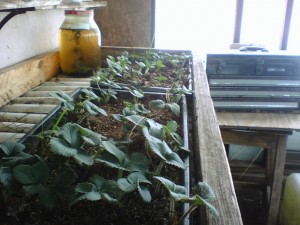 I was and I did! I got stuck on “A BUN DANCE,” though; I saw little dancing buns. I grinned maniacally…Now I can confess, I ate more than my share…way more, considering that I’m supposed to be avoiding bread during my candida cleanse…
I was and I did! I got stuck on “A BUN DANCE,” though; I saw little dancing buns. I grinned maniacally…Now I can confess, I ate more than my share…way more, considering that I’m supposed to be avoiding bread during my candida cleanse…
While many on the East Coast were rushing off to the grocery between snowfalls, I trudged the trench to Heathcote’s greenhouse, a plexiglas attachment onto a former corn crib, which is actually painted yellow, confusing many a visitor. the structure did used to be green, until then-member Mary Hall provided us with some fashion sense and now it’s yellow with periwinkle trim. I loved stepping inside our greenhouse, after pushing the door through the snow. Within were lettuces and chards in full color, next to plexiglas with snow banked five feet high!
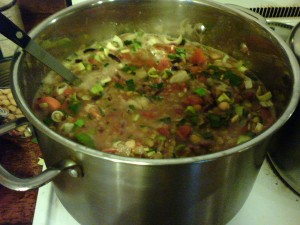 When I took my turn to cook the community meal, I was determined to fill our giant soup pot with thick, crunchy vegetable soup, so our growing community would feel well-fed a-bun-dance. The fridge was full of leeks, yellow onions, red chard, purple cabbage…Along with green lentils, some fire roasted tomatoes from a can, and more, it was chunky, colorful and satisfying.
When I took my turn to cook the community meal, I was determined to fill our giant soup pot with thick, crunchy vegetable soup, so our growing community would feel well-fed a-bun-dance. The fridge was full of leeks, yellow onions, red chard, purple cabbage…Along with green lentils, some fire roasted tomatoes from a can, and more, it was chunky, colorful and satisfying.
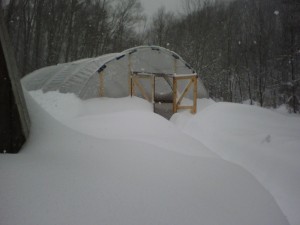 This past fall, Heathcote received a grant from the Koinonia Foundation to build a large hoophouse style greenhouse in our main garden. Many Heathcote members and friends contributed considerable labor to build it, in tandem with workshops, as part of Heathcote’s educational mission. Starting this spring, our hoophouse will significantly extend our growing season and increase the food available from Heathcote land, for both our table and market. Heathcoter Mike has been diligent about removing snow as it falls on the plastic sheeting, which wasn’t easy to put in place. Now snow banks up five feet and more around the outside. The structure has held up well with Mike’s proactive care. It’s exciting to stand inside, the space is full of potential!
This past fall, Heathcote received a grant from the Koinonia Foundation to build a large hoophouse style greenhouse in our main garden. Many Heathcote members and friends contributed considerable labor to build it, in tandem with workshops, as part of Heathcote’s educational mission. Starting this spring, our hoophouse will significantly extend our growing season and increase the food available from Heathcote land, for both our table and market. Heathcoter Mike has been diligent about removing snow as it falls on the plastic sheeting, which wasn’t easy to put in place. Now snow banks up five feet and more around the outside. The structure has held up well with Mike’s proactive care. It’s exciting to stand inside, the space is full of potential!
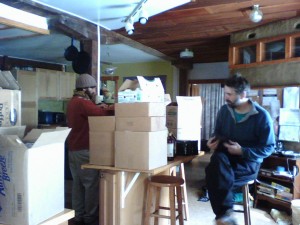 Yesterday, our monthly wholesale food delivery finally came, three days late due to road conditions, specifically our road, which had only just been plowed. Several of us gathered to unload the truck, count the boxes, inventory the order and put the food away.
Yesterday, our monthly wholesale food delivery finally came, three days late due to road conditions, specifically our road, which had only just been plowed. Several of us gathered to unload the truck, count the boxes, inventory the order and put the food away.
Our diet is vegetarian and vegan, whole foods and organic as much as possible. At Heathcote, we grow what we can. (This year, lead gardener Betsy will be supervising interns in our Permaculture based gardens.) We also collect wild edibles, such as mushrooms, off our land. Then we buy what we can, wholesale and in bulk, using our collective buying power. What we can’t get from our distributors, we buy, usually at locally owned health food stores and grocery stores, such as Sonnewald, Saubels and The Natural.
It’s always fun to help put the co-op order away; It’s like opening presents. And it’s usually much easier to plan a menu for the community dinner after the order has arrived than while it’s due. But still, as we were waiting for it and living and working in our buildings connected by trenches in the snow, I never felt a lack.
–WT
Beep-Beep! Our Cleaning Traffic Jam
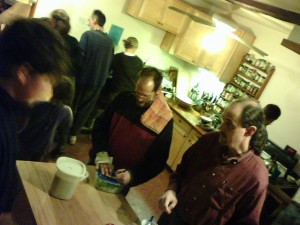 Heathcote Community is a pretty special place to live, with many unusual blessings. Friends and visitors often gush about our community dinners. Six nights a week, most of the community comes to the Mill for a shared meal. Each community member signs up to lovingly cook about thrice a month. That way, the work is light and people usually cook their particular vegetarian specialties, making the Heathcote cuisine legendary!
Heathcote Community is a pretty special place to live, with many unusual blessings. Friends and visitors often gush about our community dinners. Six nights a week, most of the community comes to the Mill for a shared meal. Each community member signs up to lovingly cook about thrice a month. That way, the work is light and people usually cook their particular vegetarian specialties, making the Heathcote cuisine legendary!
A few years ago, we gutted the first floor of the Mill to open up the space as we add members. We renovated and expanded our dining room and kitchen areas.
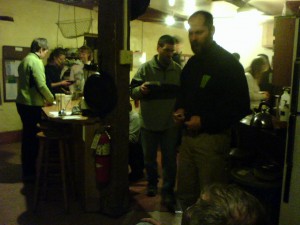 We wanted more members. So we brainstormed about recruitment and we meditated on our intention, picturing the people arriving. They did!
We wanted more members. So we brainstormed about recruitment and we meditated on our intention, picturing the people arriving. They did!
Since that time, we’ve gone from eight adults and four kids to sixteen adults and six children living on the land. I imagine the economic downturn helps our population explosion, with people who’ve considered Intentional Community for years, finally pursuing that adventure.
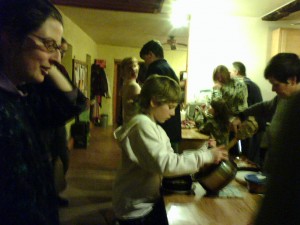 Now, long ago when we were fewer, dinner cleanup was a drag. We always had the agreement that whoever cooked for the night didn’t have to clean. But some cooks have simple ways and some cooks, well, they use every pot in the place, open twenty-seven cans and fling food on every conceivable surface. We would rotate a couple of members to clean, who were sometimes at it for hours.
Now, long ago when we were fewer, dinner cleanup was a drag. We always had the agreement that whoever cooked for the night didn’t have to clean. But some cooks have simple ways and some cooks, well, they use every pot in the place, open twenty-seven cans and fling food on every conceivable surface. We would rotate a couple of members to clean, who were sometimes at it for hours.
Then it was proposed that we try having all eaters except the cook clean up. This seemed like overkill to some, awkward to others, but we consensed to try it.
At first, I found it way overstimulating, having eight or more adult bodies in our tiny, pre-renovation kitchen. Whenever I could snag the dishwashing job and face the wall, I would. I want to be a good girl and do what’s expected, but I’m not one of those personality types who thrives on chaos.
 Folks soon found that, like our communal dinners themselves, the cleanup had become a group bonding experience. People would continue dinner conversation, sing songs, gather consensus around where things belonged in the kitchen and what do do with plastic bags–”I still can’t believe we actually wash these!!!”
Folks soon found that, like our communal dinners themselves, the cleanup had become a group bonding experience. People would continue dinner conversation, sing songs, gather consensus around where things belonged in the kitchen and what do do with plastic bags–”I still can’t believe we actually wash these!!!”
And our renovation certainly created some elbow room, smoothing out the chaos. That is, until the people we imagined showed up, picked up dish towels and asked, “Where does this thingy go?”
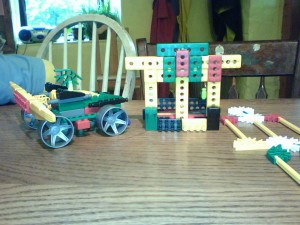 Our dining room tables used to host cooperative jigsaw puzzles, slow chess games, kid art projects, and so forth. Suddenly it’s, “Where can I sit? Who’s stuff is this? Can we make an agreement about kids’ stuff in common areas? I have some feelings about this…”
Our dining room tables used to host cooperative jigsaw puzzles, slow chess games, kid art projects, and so forth. Suddenly it’s, “Where can I sit? Who’s stuff is this? Can we make an agreement about kids’ stuff in common areas? I have some feelings about this…”
And I’m back to wishing for a cleanup job that faces the wall. But I stand there, on a team of four waiting to dry and/or put away dishes. I look around to see two dishwashers at two different sinks, one rinser, two or three dryers, three or four put-awayers, two sweepers (only two brooms), a cloud of bodies spooning leftovers into containers, labeling and dating them, and a few newbies standing on the edges, trying to figure out how to cut in and steal the ball.
 The chaos is made more delicious with the addition of the Heathcote kids to dinner cleanup. They have spent years building their own community in our Open Classroom program. After several years of using consensus to create kid systems to cook and clean up their own lunch, they understood the take and give of community. When some adults expressed concern/resentment/pissiness that kids just ran off to play after dinner, the kids problem solved and offered an agreement that kids would do twenty minutes of cleanup each night. Their presence has been heartwarming, distracting, loud, hilarious, usually effective and generally a wonderful gift.
The chaos is made more delicious with the addition of the Heathcote kids to dinner cleanup. They have spent years building their own community in our Open Classroom program. After several years of using consensus to create kid systems to cook and clean up their own lunch, they understood the take and give of community. When some adults expressed concern/resentment/pissiness that kids just ran off to play after dinner, the kids problem solved and offered an agreement that kids would do twenty minutes of cleanup each night. Their presence has been heartwarming, distracting, loud, hilarious, usually effective and generally a wonderful gift.
Lately, I’ve been counting twenty-three and more bodies at dinners. I’m curious to see what will bubble up as we co-create the systems that work for our growing community. Open Classroom went from three to five students this year. We needed to create new structures for everything, waiting for our new students to buy-in to our problem-solving consensus. What will the adults say? Should we go back to shifts of cleaner-upers? I already hear folks saying that we have too many eaters for one cook to feed. Cooking teams?
The delicious problems of success. In the meantime, outta my way! Hippie Chick with a wet dish!
Red Wiggler Farm
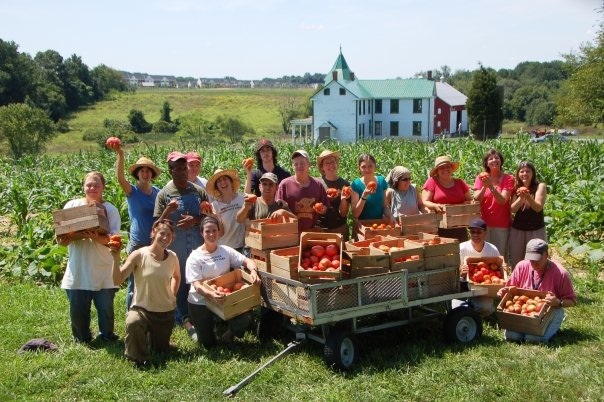 Former Heathcote Community member Andrea Barnhardt just let us know she’s working at Red Wiggler Farm, an organic CSA (community supported agriculture) that provides meaningful employment for mentally disabled adults. In CSA’s, buyer members have a stake in a farm’s crop and receive generous amounts of the harvest delivered to a central location.
Former Heathcote Community member Andrea Barnhardt just let us know she’s working at Red Wiggler Farm, an organic CSA (community supported agriculture) that provides meaningful employment for mentally disabled adults. In CSA’s, buyer members have a stake in a farm’s crop and receive generous amounts of the harvest delivered to a central location.
This sparked on my radar because my mom, Peg Finnie, used to operate Harmony Habitat on our family farm in Bloomfield, Kentucky, a group home with similar goals.
Please consider giving your support to this project.
Similarly, Camphill Communities have existed within the larger context of the intentional communities movement for years. I’d love to expand on this post but I am bound for the Howard County Fair…



